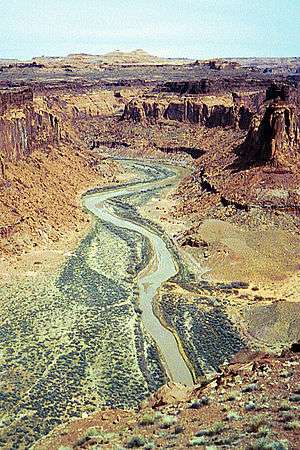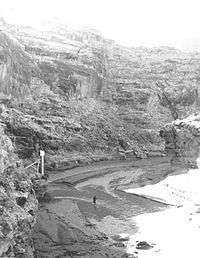Dirty Devil River
| Dirty Devil River | |
| River | |
 The Dirty Devil River near Twin Corral Box Canyon | |
| Country | United States |
|---|---|
| State | Utah |
| County | Wayne County, Garfield County |
| Tributaries | |
| - left | Muddy Creek |
| - right | Fremont River |
| Source | Confluence of Fremont River and Muddy Creek |
| - elevation | 4,266 ft (1,300 m) [1] |
| - coordinates | 38°24′9″N 110°41′35″W / 38.40250°N 110.69306°W [2] |
| Mouth | Colorado River |
| - location | Lake Powell, Glen Canyon National Recreation Area, Garfield County, Utah |
| - elevation | 3,703 ft (1,129 m) [3] |
| - coordinates | 37°53′30″N 110°23′33″W / 37.89167°N 110.39250°WCoordinates: 37°53′30″N 110°23′33″W / 37.89167°N 110.39250°W [2] |
| Length | 80 mi (129 km) [4] |
| Discharge | |
| - average | 101 cu ft/s (3 m3/s) [5] |
| - max | 35,800 cu ft/s (1,014 m3/s) |
| - min | 0 cu ft/s (0 m3/s) |
|
Location of the mouth of the Dirty Devil River in Utah
| |

The Dirty Devil River is an 80-mile-long (130 km) tributary of the Colorado River, located in the U.S. state of Utah. It flows through southern Utah from the confluence of Fremont River and Muddy Creek to the Colorado River.
Course
The Dirty Devil River is formed in Wayne County near Hanksville at the confluence of the Fremont River and Muddy Creek. It flows generally south through a 2,000 feet (610 m) deep canyon in Wayne and Garfield counties. Its lower 20 miles (32 km) flows through Glen Canyon National Recreation Area. It disembogues into Lake Powell on the Colorado.
The canyon of the river is particularly isolated and is seldom visited compared to other natural areas in the region. The average discharge is approximately 446 cfs.
History
The Dirty Devil River was named during the 1869 Colorado River expedition led by John Wesley Powell.[6]
The outlaw Butch Cassidy used tributary canyons of the Dirty Devil, such as Robbers Roost, as a hideout in the 1890s.[6]
Geology
The Dirty Devil River and its tributaries contribute approximately 150,000 tons of salt to the Colorado River each year, with the Muddy Creek tributary contributing an annual average of 86,000 tons by itself. The Fremont River tributary does not contribute significant amounts of salt. The United States Bureau of Reclamation has created a plan to reduce the salinity of the Dirty Devil River by collecting salty spring water and using deep-well injection to dispose of it. The plan, completed in 1987, has not been implemented due to its marginal cost effectiveness.[7]
Bridges
The river is spanned by a steel arch bridge on State Route 95 near milepost 45 in Garfield County.
See also
References
- ↑ Source elevation derived from Google Earth search using GNIS source coordinates.
- 1 2 U.S. Geological Survey Geographic Names Information System: Dirty Devil River
- ↑ Mouth elevation derived from Google Earth search using GNIS mouth coordinates.
- ↑ Dirty Devil River, The Columbia Gazetteer of North America
- ↑ http://wdr.water.usgs.gov/wy2013/pdfs/09333500.2013.pdf
- 1 2 Dirty Devil River, Bureau of Land Management
- ↑ Colorado River Basin Salinity Control Program, Dirty Devil, Utah, USBR


